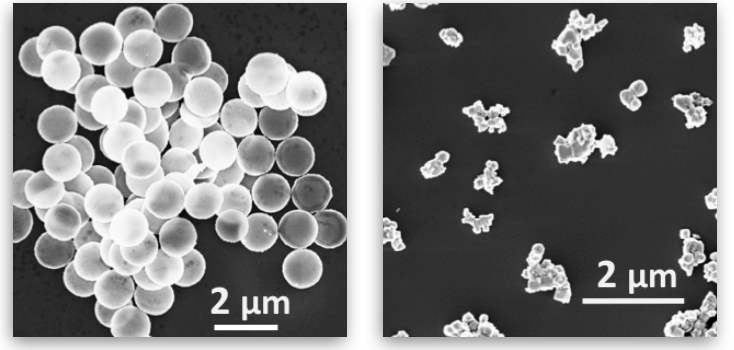In the context of the fight against cancer, magnetic nanoparticles are used for several purposes: tissue labeling for imaging, targeting of drug delivery, destruction of cancer cells by magnetic heating, etc. A more general line of research focuses on the effect of local mechanical forces applied to the cell to modify its physiology or behavior. It has been shown, for example, that the vibration of micron-sized magnetic particles, by applying an external low-frequency magnetic field, leads to cell death in a few minutes.
The most commonly used nanoparticles for biomedical applications are made of iron oxide, with a size of at most a few tens of nanometers. However, these are much too small to generate the magneto-mechanical forces likely to disrupt the cell, which requires micron-sized particles instead. Such magnetic particles (MP) have been developed at IRIG, for example in the form of permalloy disks (alliage Ni80Fe20) a few tens of nanometers thick (Figure left). These particles are made by optical lithography in a clean room. They have the disadvantage of a high manufacturing cost and a low production yield. On the other hand, studies conducted in vivo where the particles were injected into a tumor have shown that they circulate very little at the tumor tissue level, thus preventing a global action on the whole tumor.
To overcome these drawbacks, researchers at IRIG [collaboration] have developed a new type of magnetic microparticles. These are magnetite particles, obtained by grinding a magnetite powder, which allows mass production at reduced cost. Their size, about one micron, is optimized so that their vibration induces the desired mechanical stress on the cells (Figure right). After obtaining the desired granulometry, the microparticles are covered with a silica envelope on which are grafted various types of PEG ligands (poly(ethylene glycol)). The choice of grafting PEG molecules, which form an envelope of flexible molecules of varying lengths on their surface, was to improve their dispersion within the cells.

Left: Magnetic permalloy microparticles manufactured by optical lithography.
Right: Magnetite microparticles made by grinding powder. Credit CEA
The first step in validating these new microparticles was to verify their intrinsic toxicity on glioblastoma cells, an extremely aggressive form of brain cancer, through an in vitro study. The particles were found to be well tolerated up to the highest doses. These tests also showed that grafting with PEG considerably improves the dispersion of the particles in the middle of the cells, which was one of the desired effects.
The second validation step consists in observing the effect on the cells of the vibration of the particles under the action of an external magnetic field of frequency ranging from 2 to 20Hz. An interesting result emerges if we compare the effect of bare particles and the effect of particles coated with PEG (MP-PEG): while bare particles lead to the death of 90% of the cells, the vibration of MP-PEG leads to a lower mortality. Nevertheless, cells exposed to MP-PEGs showed a proportionally higher ratio in apoptotic death. Moreover, the increase in apoptosis is more pronounced at the lowest vibration frequency (2 Hz).
These results highlight a difference in the mechanism of cell death depending on the type of particles (functionalized or not) and the conditions of the mechanical stimulation. One hypothesis would be that this difference could be attributed to the damping of vibrations by PEG chains: where more energetic vibrations would lead to cell necrosis by membrane rupture, the softer vibrations and damping induced by PEG would initiate a chain of cellular reactions leading to apoptosis.
These results open the door to further studies of the effect of magneto-mechanical vibrations on the cell, both in the context of research into new therapies and in the more fundamental context of research into cellular mechanosensitivity.
Apoptosis (or programmed cell death) is the process by which cells trigger their self-destruction in response to a signal. Death by necrosis results in the dispersal of the cancer cell's contents throughout the body, which can contribute to the spread of metastasis. Conversely, during the process of apoptosis, the cellular debris is evacuated without harmful consequences for the organism.
Collaboration: Molecular Systems and nanoMaterials for Energy and Health laboratory (SyMMES).